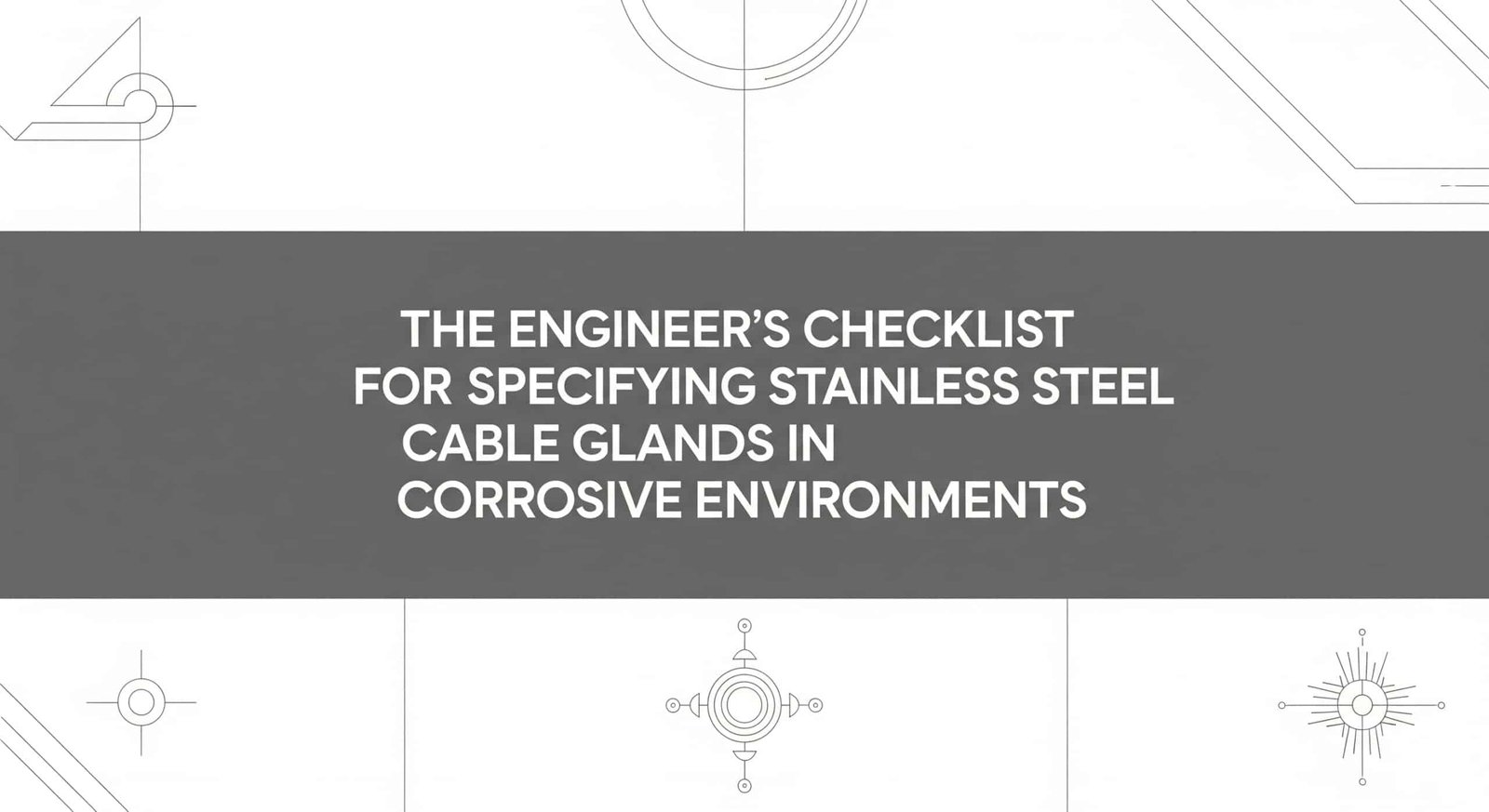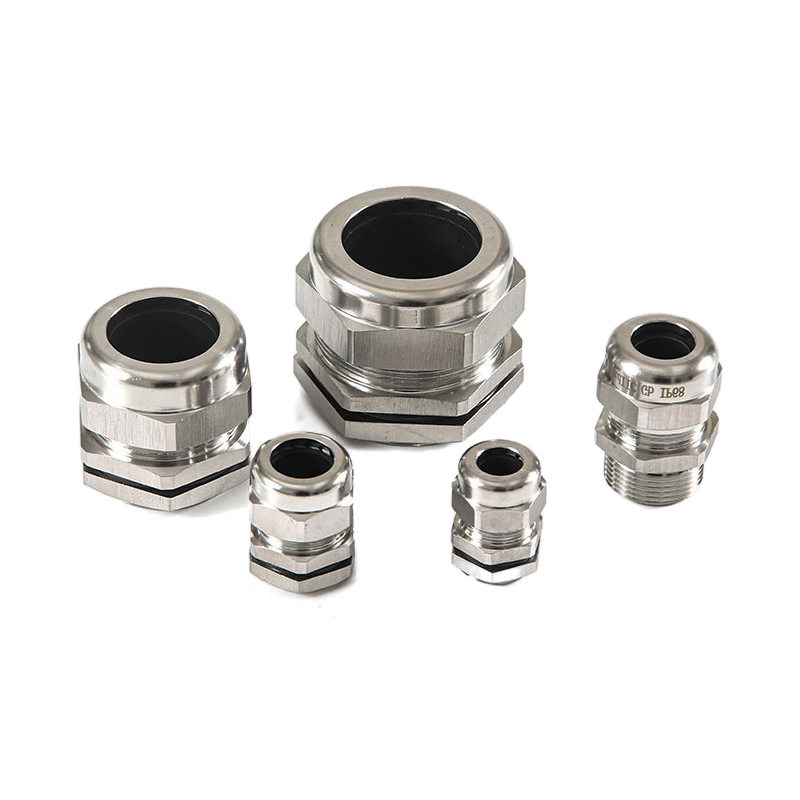Introduction
Watching expensive equipment fail because you chose the wrong cable gland material is every engineer’s nightmare. One small oversight in material specification can lead to catastrophic system failures, safety incidents, and millions in replacement costs. The invisible enemy of corrosion doesn’t give second chances – it attacks relentlessly until your protection fails completely.
Specifying stainless steel cable glands for corrosive environments requires systematic evaluation of chemical compatibility, grade selection (316L vs 304), environmental factors, certification requirements, and long-term performance criteria to ensure reliable protection against specific corrosive agents while maintaining electrical safety and regulatory compliance.
Last month, Hassan, chief engineer at a desalination plant1 in Dubai, called me desperately after discovering severe corrosion on their cable gland installations just 18 months after commissioning. Despite specifying “stainless steel” glands, the wrong grade selection and inadequate gasket materials led to $2.3 million in equipment replacement costs. This comprehensive checklist prevents such costly mistakes by ensuring you specify exactly the right protection for your specific corrosive environment.
Table of Contents
- What Makes Stainless Steel Essential for Corrosive Environments?
- How Do You Select the Right Stainless Steel Grade?
- What Environmental Factors Must You Evaluate?
- Which Certifications and Standards Are Critical?
- How Do You Ensure Long-Term Performance?
- FAQs About Stainless Steel Cable Glands
What Makes Stainless Steel Essential for Corrosive Environments?
Standard cable glands might look adequate on paper, but in corrosive environments, they’re like paper umbrellas in a hurricane – completely inadequate when you need protection most.
Stainless steel cable glands provide superior corrosion resistance through chromium oxide passive layers2, excellent mechanical strength at extreme temperatures, chemical inertness against acids and alkalis, and long-term dimensional stability that maintains sealing integrity where standard materials fail within months.
Corrosion Resistance Mechanisms
The secret weapon of stainless steel lies in its self-healing chromium oxide layer. When exposed to oxygen, chromium forms an invisible protective barrier that continuously regenerates when damaged. This passive layer provides ongoing protection that brass, aluminum, or plastic materials simply cannot match.
Key Protective Properties:
- Chromium content (minimum 10.5%) creates passive oxide layer
- Self-healing capability – scratches automatically re-passivate in oxygen
- Chemical inertness – resists attack from acids, bases, and chlorides
- Temperature stability – maintains properties from -196°C to +400°C
- Galvanic compatibility3 – prevents dissimilar metal corrosion issues
Real-World Performance Data
David, a maintenance engineer at a petrochemical facility in Texas, documented the dramatic difference between materials over a five-year operational period:
| Material Type | Service Life | Replacement Cost | Annual Maintenance |
|---|---|---|---|
| Nylon 66 | 8 months | $15,000/year | 120 hours |
| Brass (Nickel-plated) | 18 months | $25,000/cycle | 80 hours |
| 304 Stainless Steel | 8+ years | $8,000 initial | 10 hours/year |
| 316L Stainless Steel | 15+ years | $12,000 initial | 5 hours/year |
While 316L stainless steel glands cost 6-8x more initially, David’s facility calculated a 340% return on investment over five years through eliminated replacement costs and reduced maintenance downtime.
Chemical Resistance Advantages
Acid Environments:
- Sulfuric acid – 316L handles concentrations up to 10% at ambient temperature
- Hydrochloric acid – limited resistance, requires specialized grades for high concentrations
- Nitric acid – excellent resistance across wide concentration ranges
- Organic acids – superior performance with acetic, formic, and citric acids
Marine and Chloride Environments:
Hassan’s Dubai desalination plant represents the ultimate test environment with 19,000+ ppm chloride content, high humidity, and temperature cycling. The 316L stainless steel’s molybdenum content provides enhanced pitting resistance that standard grades cannot achieve.
At Bepto, we manufacture 316L stainless steel cable glands that undergo 1000-hour salt spray testing per ASTM B1174, ensuring they meet the demanding requirements of the world’s most corrosive environments.
How Do You Select the Right Stainless Steel Grade?
Choosing between stainless steel grades isn’t about picking the most expensive option – it’s about matching specific metallurgical properties to your exact corrosive environment and operating conditions.
Stainless steel grade selection depends on specific corrosive agents present, operating temperature range, mechanical stress requirements, and cost considerations, with 316L offering superior chloride resistance for marine/chemical environments, while 304 provides adequate protection for mild corrosive conditions at lower cost.
Grade Comparison Matrix
304 Stainless Steel (18-8 Grade):
- Composition: 18% chromium, 8% nickel, low carbon content
- Best applications: Food processing, architectural, mild chemical environments
- Limitations: Poor chloride resistance, susceptible to pitting in marine environments
- Cost factor: 1.0x baseline stainless steel pricing
316L Stainless Steel (18-10-2 Grade):
- Composition: 18% chromium, 10% nickel, 2% molybdenum, low carbon
- Best applications: Chemical processing, marine, pharmaceutical, pulp/paper
- Advantages: Superior pitting and crevice corrosion resistance
- Cost factor: 1.3-1.5x compared to 304 grade
Chemical Compatibility Assessment
The key to proper grade selection is understanding acceptable corrosion rates for your specific application:
Industry Standard Corrosion Rates:
- Excellent resistance: <0.1 mm/year (recommended for critical applications)
- Good resistance: 0.1-0.5 mm/year (acceptable for most industrial uses)
- Fair resistance: 0.5-1.0 mm/year (limited service life expected)
- Poor resistance: >1.0 mm/year (not recommended for long-term service)
Chemical-Specific Selection Guide:
| Chemical Environment | 304 SS Rating | 316L SS Rating | Recommended Choice |
|---|---|---|---|
| Mild acids (<5%) | Good | Excellent | 316L for longevity |
| Chloride solutions | Poor | Good | 316L minimum |
| Marine/seawater | Poor | Good | 316L standard |
| Caustic solutions | Good | Good | 304 cost-effective |
| Organic solvents | Excellent | Excellent | 304 adequate |
Specialized Grade Considerations
For extreme environments, David’s Texas petrochemical facility required super austenitic grades5:
Super Austenitic Stainless Steels:
- 254 SMO (6% Molybdenum) – extreme chloride resistance for seawater applications
- AL-6XN – high strength with superior corrosion resistance
- Cost factor: 3-4x standard 316L pricing
- Applications: Seawater desalination, high-chloride chemical processes
Cost-Benefit Analysis Example:
David’s facility performed 20-year total cost analysis:
| Grade Selection | Initial Cost | Replacement Cycles | Total 20-Year Cost |
|---|---|---|---|
| 304 Stainless | $100,000 | 3 replacements | $345,000 |
| 316L Stainless | $135,000 | 1 replacement | $285,000 |
| Super Austenitic | $200,000 | 0 replacements | $208,000 |
Result: Super austenitic grade provided lowest total cost despite 2x initial premium.
What Environmental Factors Must You Evaluate?
Environmental assessment isn’t just about checking boxes – it’s about understanding how multiple corrosive factors interact to create conditions that can destroy inadequately specified cable glands.
Critical environmental factors include chemical composition and concentration, temperature extremes and cycling, humidity and moisture exposure, atmospheric contaminants, galvanic corrosion potential, and mechanical stresses that combine to determine the required level of corrosion protection.
Chemical Environment Analysis
Primary Corrosive Agents Assessment:
Hassan’s Dubai facility required comprehensive chemical analysis:
Seawater Composition Analysis:
- Chloride content: 19,000-20,000 ppm (extremely aggressive to standard materials)
- Sulfate content: 2,700 ppm (moderate additional corrosion risk)
- pH range: 7.8-8.2 (slightly alkaline, generally favorable)
- Dissolved oxygen: 6-8 ppm (accelerates corrosion processes)
- Operating temperature: 25-45°C (increases corrosion reaction rates)
Secondary Chemical Factors:
- Cleaning chemicals: Sodium hypochlorite biocide (chlorine-based oxidizer)
- Scale inhibitors: Phosphonate-based chemicals (generally compatible)
- Coagulants: Ferric chloride additions (increases chloride concentration)
- pH adjustment: Sulfuric acid dosing (creates localized acidic conditions)
Atmospheric and Physical Conditions
Temperature Impact Factors:
- Daily cycling: 15-40°C range causes thermal stress and condensation formation
- Seasonal extremes: -5°C to 50°C annual range affects material properties
- Process heat: Local hot spots up to 80°C from equipment radiation
- Thermal shock: Rapid temperature changes during process upsets
Humidity and Moisture Control:
- Relative humidity >60%: Significantly accelerates atmospheric corrosion
- Condensation cycles: Create wet/dry conditions promoting crevice corrosion
- Salt spray exposure: Coastal environments require enhanced protection levels
- Washdown requirements: High-pressure cleaning with chemical solutions
Galvanic Corrosion Assessment
Critical Material Compatibility:
When stainless steel glands connect to dissimilar metals, galvanic corrosion becomes a major concern:
Galvanic Series in Seawater (Anodic to Cathodic):
- Most Anodic (corrodes): Aluminum, zinc, carbon steel, brass
- Intermediate: Copper, lead, tin
- Most Cathodic (protected): Stainless steel, titanium, platinum
Prevention Strategies:
- Material isolation: Use insulating gaskets between dissimilar metals
- Compatible fasteners: Specify stainless steel bolts and hardware
- Sacrificial anodes: Install zinc or aluminum anodes for protection
- Electrical isolation: Break galvanic circuits where possible
At Bepto, we provide comprehensive galvanic compatibility charts and recommend appropriate isolation techniques for each installation to prevent costly galvanic corrosion failures.
Which Certifications and Standards Are Critical?
Navigating certification requirements isn’t bureaucratic paperwork – it’s your insurance policy against catastrophic failures, regulatory violations, and legal liability in safety-critical applications.
Critical certifications include IP ingress protection ratings, ATEX/IECEx explosion-proof compliance, marine classification society approvals, FDA/3A sanitary standards, and industry-specific requirements that ensure safety, performance, and regulatory compliance in corrosive environments.
Essential Safety Certifications
IP (Ingress Protection) Ratings:
- IP66: Dust-tight, protected against heavy seas and powerful water jets
- IP67: Dust-tight, protected against temporary immersion up to 1 meter depth
- IP68: Dust-tight, protected against continuous submersion (depth specified by manufacturer)
- IP69K: Dust-tight, protected against high-pressure, high-temperature washdown
Hassan’s Dubai facility requires IP68 rating with 3-meter depth capability for cable glands in pump stations subject to potential flooding during maintenance operations.
Explosion-Proof Certifications:
- ATEX (European): Essential for hazardous area installations in chemical facilities
- IECEx (International): Global recognition for reduced testing and certification costs
- UL/CSA (North American): Required for US and Canadian installations
- PESO (Indian): Mandatory for explosive atmosphere applications in India
Marine and Offshore Standards
Classification Society Approvals:
- Lloyd’s Register (LR): Global marine certification authority
- DNV GL: Leading offshore and marine technology certification
- American Bureau of Shipping (ABS): US-based marine classification requirements
- Bureau Veritas (BV): International marine and offshore certification
Marine Testing Requirements:
- Salt spray testing: 1000+ hours per ASTM B117 standard
- Vibration testing: Ship and offshore platform vibration profiles
- Temperature cycling: Marine environment temperature extremes
- UV resistance: Extended exposure to marine UV radiation conditions
Industry-Specific Standards
Food and Pharmaceutical Applications:
- FDA CFR 21: Food contact material regulations and compliance
- 3A Sanitary Standards: Dairy and food processing equipment requirements
- cGMP compliance: Current Good Manufacturing Practice for pharmaceuticals
- EHEDG guidelines: European hygienic engineering and design standards
Nuclear and Power Generation:
- 10CFR50 Appendix B: Nuclear quality assurance program requirements
- IEEE 323: Environmental qualification for safety-related equipment
- ASME Section III: Nuclear component design and manufacturing standards
- Seismic qualification: Earthquake resistance for safety-critical systems
David’s Texas facility maintains comprehensive certification documentation including material test certificates, third-party testing reports, and ongoing surveillance audit records to ensure continued compliance with all applicable standards.
How Do You Ensure Long-Term Performance?
Long-term reliability isn’t achieved by hoping your cable glands will last – it requires systematic design for durability, proper installation practices, and proactive maintenance strategies.
Ensuring long-term performance requires selecting appropriate grades and finishes, implementing proper installation techniques, establishing preventive maintenance programs, monitoring performance indicators, and planning systematic replacement based on actual service life data rather than arbitrary schedules.
Design for Longevity
Material Selection Optimization:
Hassan’s Dubai facility implemented a comprehensive 25-year service life strategy:
Enhanced Specifications:
- 316L stainless steel minimum for all chloride-exposed applications
- Super austenitic upgrade for critical systems (main pumps, control panels)
- Electropolished surface finish to minimize contamination retention
- FFKM gasket materials (perfluoroelastomer) for chemical resistance
Surface Finish Impact:
- Standard mill finish (2B): Smooth, reflective surface adequate for most applications
- Electropolished finish: Ra <0.4 μm for enhanced corrosion resistance
- Passivated surface: Citric acid treatment optimizes passive layer formation
- Special coatings: PVD or ceramic coatings for extreme chemical environments
Installation Best Practices
Critical Installation Procedures:
- Surface preparation: Remove all paint, coatings, and contamination from mounting surfaces
- Thread preparation: Clean threads thoroughly, apply appropriate thread sealant
- Gasket inspection: Verify material compatibility and proper condition
- Torque specification: Use calibrated tools to achieve manufacturer specifications
Environmental Considerations:
- Drainage design: Ensure water cannot accumulate around installations
- Ventilation provision: Adequate air circulation prevents condensation buildup
- Access planning: Design for inspection and maintenance accessibility
- Material compatibility: Verify all components are galvanically compatible
Preventive Maintenance Programs
Systematic Inspection Schedule:
| Inspection Type | Frequency | Key Checkpoints | Documentation |
|---|---|---|---|
| Visual Inspection | Monthly | Corrosion signs, gasket condition | Checklist |
| Torque Verification | Quarterly | Compression, mounting integrity | Readings |
| Electrical Testing | Semi-annually | Continuity, insulation resistance | Certificates |
| Detailed Inspection | Annually | Disassembly, component replacement | Records |
Performance Monitoring:
- Corrosion rate measurement: Electrical resistance probes for real-time monitoring
- Environmental tracking: Temperature, humidity, chemical concentration logging
- Failure analysis: Root cause investigation for any premature failures
- Cost tracking: Monitor total cost of ownership including maintenance
David’s facility uses comprehensive monitoring systems that have reduced unplanned maintenance by 75% while extending average service life from 5 years to 12+ years through proactive intervention.
At Bepto, we provide detailed installation guides, maintenance schedules, and technical support to ensure our stainless steel cable glands deliver maximum service life in your specific corrosive environment. Our engineering team is available for consultation on material selection, installation procedures, and long-term maintenance planning. 😉
FAQs About Stainless Steel Cable Glands
Q: What’s the difference between 304 and 316L stainless steel cable glands?
A: 316L contains 2% molybdenum which provides superior resistance to chloride corrosion and pitting, making it essential for marine and chemical environments. 304 is adequate for mild corrosive conditions but will fail rapidly in chloride-rich environments like seawater or chemical processing.
Q: How do I know if my environment requires stainless steel cable glands?
A: Choose stainless steel if you have chloride exposure above 100ppm, temperatures above 60°C, chemical cleaning requirements, or marine/offshore installations. Standard brass or nylon glands will corrode within months in these conditions, while stainless steel provides 15+ year service life.
Q: Are stainless steel cable glands worth the higher cost?
A: Yes, for corrosive environments. While initial cost is 6-8x higher than brass, total cost of ownership is typically 60-70% lower due to eliminated replacement cycles and reduced maintenance. The payback period is usually 18-24 months in moderately corrosive environments.
Q: What certifications should I look for in stainless steel cable glands?
A: Essential certifications include IP68 for water protection, ATEX/IECEx for hazardous areas, and marine approvals (Lloyd’s Register, DNV GL) for offshore use. Also verify material certificates showing actual 316L composition and corrosion testing per ASTM standards.
Q: How often should stainless steel cable glands be inspected in corrosive environments?
A: Monthly visual inspections for corrosion signs, quarterly torque verification, and annual detailed inspection with disassembly. Install corrosion monitoring probes for real-time tracking in critical applications. Proper monitoring can extend service life by 50% through early intervention.
-
Learn about the reverse osmosis process used in modern desalination plants and the challenges of material corrosion. ↩
-
Explore the science behind the self-healing passive layer that gives stainless steel its corrosion resistance. ↩
-
See a galvanic series chart to understand how dissimilar metals interact and prevent galvanic corrosion. ↩
-
Review the details of the ASTM B117 standard, the industry benchmark for salt spray corrosion testing. ↩
-
Discover the properties and common grades of super austenitic stainless steels designed for extreme environments. ↩




